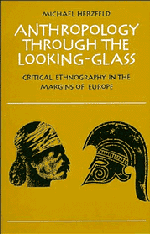Book contents
- Frontmatter
- Contents
- Preface
- Key to symbols
- 1 Romanticism and Hellenism: burdens of otherness
- 2 A secular cosmology
- 3 Aboriginal Europeans
- 4 Difference as identity
- 5 The double-headed eagle: self-knowledge and self-display
- 6 Strict definitions and bad habits
- 7 The practice of relativity
- 8 Etymologies of a discipline
- Notes
- Bibliography
- Index
4 - Difference as identity
Published online by Cambridge University Press: 11 March 2010
- Frontmatter
- Contents
- Preface
- Key to symbols
- 1 Romanticism and Hellenism: burdens of otherness
- 2 A secular cosmology
- 3 Aboriginal Europeans
- 4 Difference as identity
- 5 The double-headed eagle: self-knowledge and self-display
- 6 Strict definitions and bad habits
- 7 The practice of relativity
- 8 Etymologies of a discipline
- Notes
- Bibliography
- Index
Summary
The European ideology: diversity in unity
The European ideology developed in part from a reaction to Enlightenment universalism. Characteristically, it represented European identity as revealed through specific national identities; paradoxically, it meant thinking nationalistically. The European ideology portrayed the internal disunity of the European peoples as a transcendent unity, their political divisions as a sign of robust health, and their squabbles as the free expression of individuality refined through constant competition.
This stance was fundamental to the emergence of the European nationstate (Hazard 1935:30–1; Chabod 1964:85, 1967). Until well on in the sixteenth century, Europeans felt safe in assuming their own moral and cultural superiority. But this was always an uneasy conviction. Columbus showed moments of doubt at the very start of contact with the New World (Hodgen 1964:18); less than a century later, de Léry's (1578) comparison of cannibalism with usury (see Chabod 1964:68; Schwimmer 1983) reduced the gap between wild savages and urbane Europeans. Closer acquaintance with China, notably through the accounts of Giovanni Botero and Ludovico Guicciardini (Chabod 1964:79), made it still harder to insist on an unqualified European superiority, since Chinese culture appeared to satisfy the most ethnocentric occidental criteria of “civilization.” In the century that followed these remarkable explorations, therefore, a new understanding of European distinctiveness emerged - based, it was claimed (Hazard 1935:30–1; Chabod 1964:85, 1967), not on superiority, but on internal diversity. Such abnegations of hierarchical difference seem ironic, however, in the light of Dumont's observation that difference inevitably implies some measure of hierarchy.
- Type
- Chapter
- Information
- Anthropology through the Looking-GlassCritical Ethnography in the Margins of Europe, pp. 77 - 94Publisher: Cambridge University PressPrint publication year: 1988



